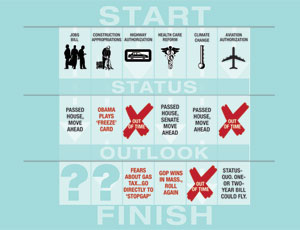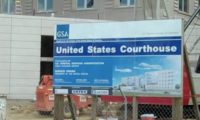When President Obama sends his 2011 budget plan to Capitol Hill, he will propose freezing non-defense discretionary spending—which includes most construction programs—at 2010’s level for the next three years. Construction executives hope Obama will keep some infrastructure line items unscathed or maybe even recommend some hikes. But the final numbers are up to Congress and won’t emerge until after months of partisan, election-year budget battling. Complicating the picture further, Democrats have seen their razor-thin, filibuster-proof 60-vote majority slip to a vulnerable 59 votes with Republican Scott Brown’s win in the Jan. 19 Massachusetts Senate race.
That outcome quickly caused Democrats to revisit their plan for health-care legislation, probably aiming for a less-sweeping Plan B. While construction officials watch health-care developments, they also are trying to figure out how the changed Senate landscape will affect other bills. Some of the most important involve money: a possible new jobs-producing bill, 2011 appropriations and surface-transportation reauthorization.
Stephen Sandherr, the Associated General Contractors’ CEO, says the path to getting increased infrastructure funding through Congress already was a steep one before Brown’s victory. Now, Sandherr says, that election’s outcome “makes the climb just a tad steeper.”
In drawing up the proposed spending freeze, White House officials decided not to call for an across-the-board percentage cutback. Instead, Rob Nabors, the Office of Management and Budget’s deputy director, told reporters on Jan. 26 they are recommending that overall “non-security” funding be held for three years at 2010’s level of $447 billion. Programs exempted from the cap are those at the Depts. of Defense, Veterans Affairs and Homeland Security, as well as the international affairs category.
“It is a top-line freeze,” Nabors says. “It is not a freeze on every agency or every program.” In words that may give hope to public-works advocates, he adds, “There are going to be increases for certain presidential priorities.” Nabors declined to provide many specifics but did say some items that are “most important to the President” include “things like education, things like energy research. They’re at the top of the list.”
Congress is nearly certain to pass appropriations for fiscal year 2011, which starts in less than nine months, though lawmakers almost surely will act later rather than sooner. Obama’s freeze proposal will only intensify the pressure to hold down spending that has been in evidence long before Brown’s win in Massachusetts.
As the 2011 appropriations round nears its start, Greg Cohen, president of the American Highway Users Alliance, notes that Obama has publicly supported a new jobs bill and more spending on roads and bridges. Cohen says, “Our hope is...that highways will still do OK” under the proposed freeze.
“But frankly,” he adds, “right now we’re under a freeze until we get some momentum on a multiyear bill.” The last multiyear highway-transit measure expired on Sept. 30, 2009, and the programs have been running under extensions since then. Cohen and other veterans of the transportation bill tussles don’t see the Democrats’s thinner majority as affecting the outlook for a new long-term highway-transit bill. “Frankly, we don’t see reauthorization being done before the [November] election,” he says. The same barrier remains in place: not enough congressional support for raising the motor-fuels tax to pay for the major increases industry and its allies desire. Even so, lawmakers aren’t likely to let the highway and transit programs lapse, which means another stopgap measure is coming.
Another top construction priority is a jobs bill to follow last year’s American Recovery and Reinvestment Act. Obama has called for a new bill, with infrastructure spending. Industry supported the $154-billion jobs bill the House...





Post a comment to this article
Report Abusive Comment